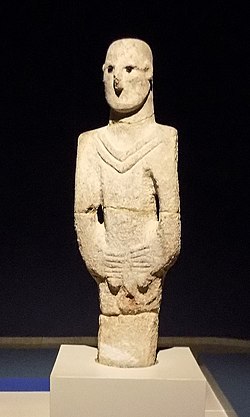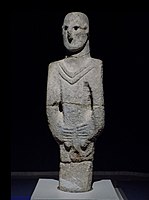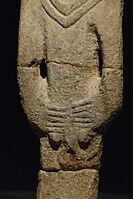The Urfa man, also known as the Balıklıgöl statue, is an ancient human shaped statue found during excavations in Balıklıgöl near Urfa, in the geographical area of Upper Mesopotamia, in the southeast of modern Turkey.[1][2] It is dated c. 9000 BC to the period of the Pre-Pottery Neolithic, and was considered as "the oldest naturalistic life-sized sculpture of a human".[3] It is considered as contemporaneous with the sites of Göbekli Tepe (Pre-Pottery Neolithic A/B) and Nevalı Çori (Pre-Pottery Neolithic B).[4]
| Urfa Man | |
|---|---|
 Urfa man, in the Şanlıurfa Museum | |
| Material | Sandstone |
| Size | 1.80 meters |
| Created | c. 9000 BC |
| Present location | Şanlıurfa Museum, Turkey |
Discovery
The statue was found during construction work, and the exact location of the find has not been properly recorded, but it may have come from the nearby Pre-Pottery Neolithic A site of Urfa Yeni-Yol.[1] This is not far from other known Pre-Pottery Neolithic A sites around Urfa: Göbekli Tepe (about 10 kilometers), Gürcütepe.[1] It is reported that it was discovered in 1993 on Yeni Yol street in Balıklıgöl, at the same location where a Pre-Pottery Neolithic site was investigated from 1997.[5]
The statue is nearly 1.90 meters tall.[6] The eyes form deep holes, in which are set segments of black obsidian.[3] It features a V-shaped collar or necklace.[5][3] The hands are clasped in front, covering the genitals.[5] The statue is thought to date to around 9000 BC, and is often claimed to be the oldest known statue in the world.[5][7][8]
Context
Before the Urfa Man, numerous small-sized statuettes are known from the Upper Paleolithic, such as the Löwenmensch figurine (c. 40,000 BC), the Venus of Dolní Věstonice (c. 30,000 BC), the Venus of Willendorf (c. 25,000 BC) or the realistic Venus of Brassempouy (c. 25,000 BC).
Slightly later than the Urfa Man, Pre-Pottery Neolithic C, anthropomorphic statues are known from the Levant, such as the 'Ain Ghazal Statues. In 2023, it was announced that excavations carried out at Karahan Tepe have turned up a human statue dates back to around 9,400 BC. [9]
Details
- Another view of the statue
- Urfa man portrait, with obsidian stones in the eye sockets
- Urfa man detail
See also





